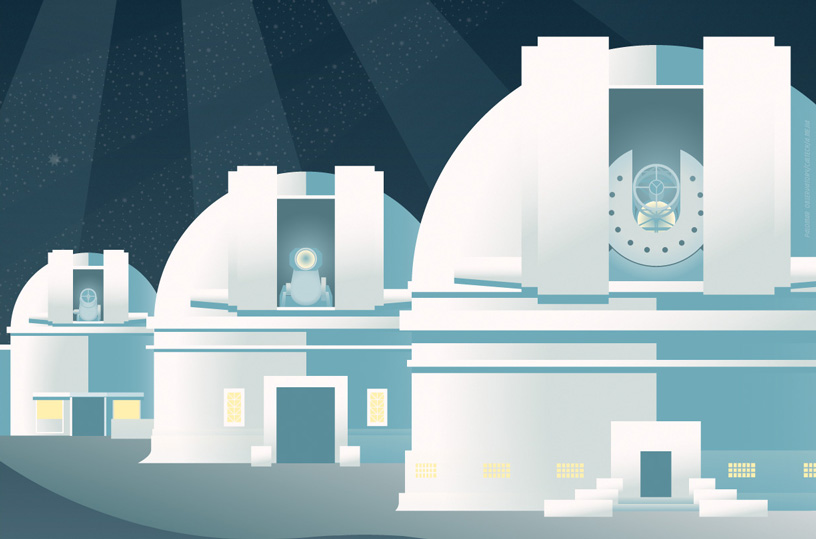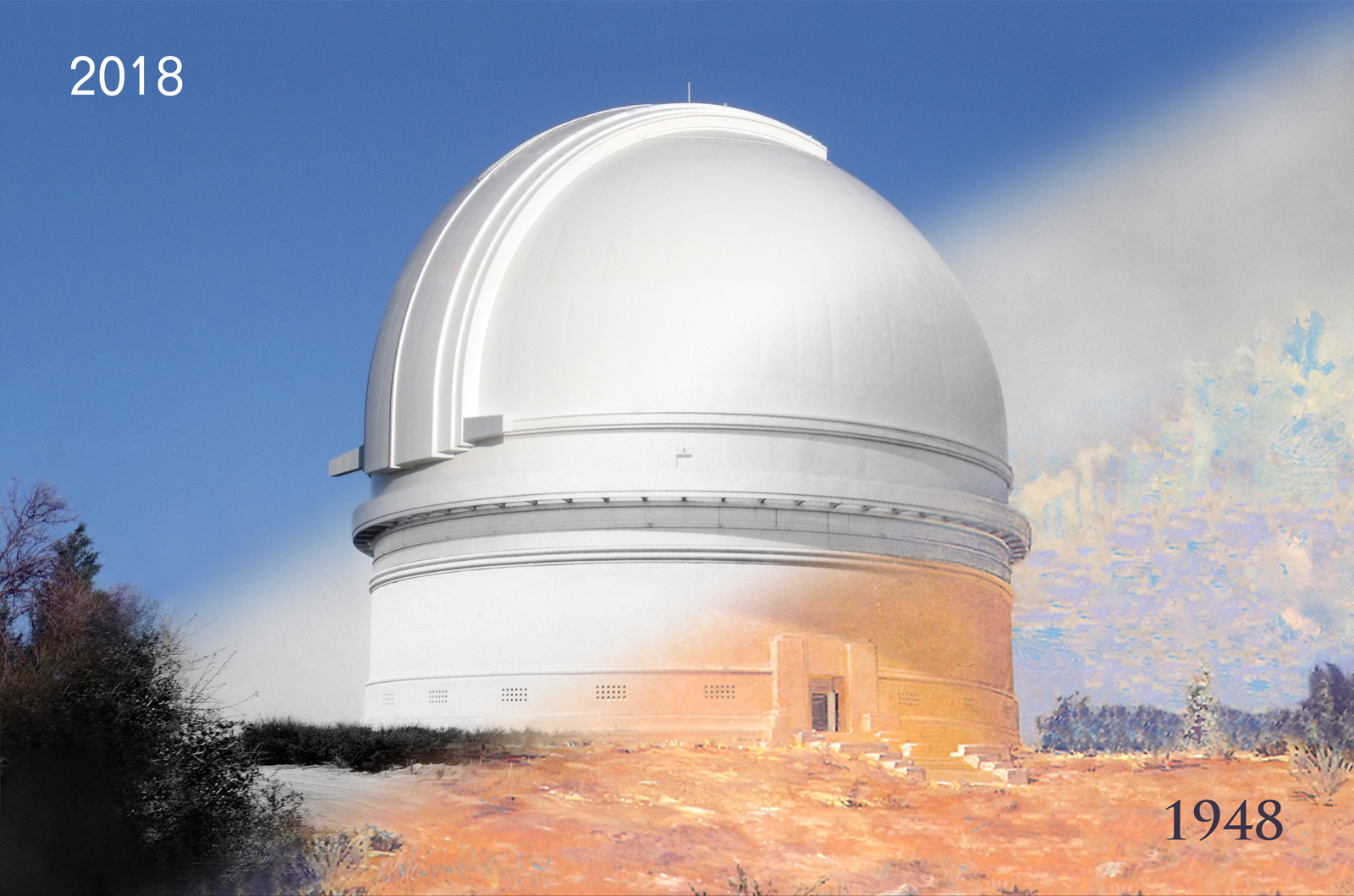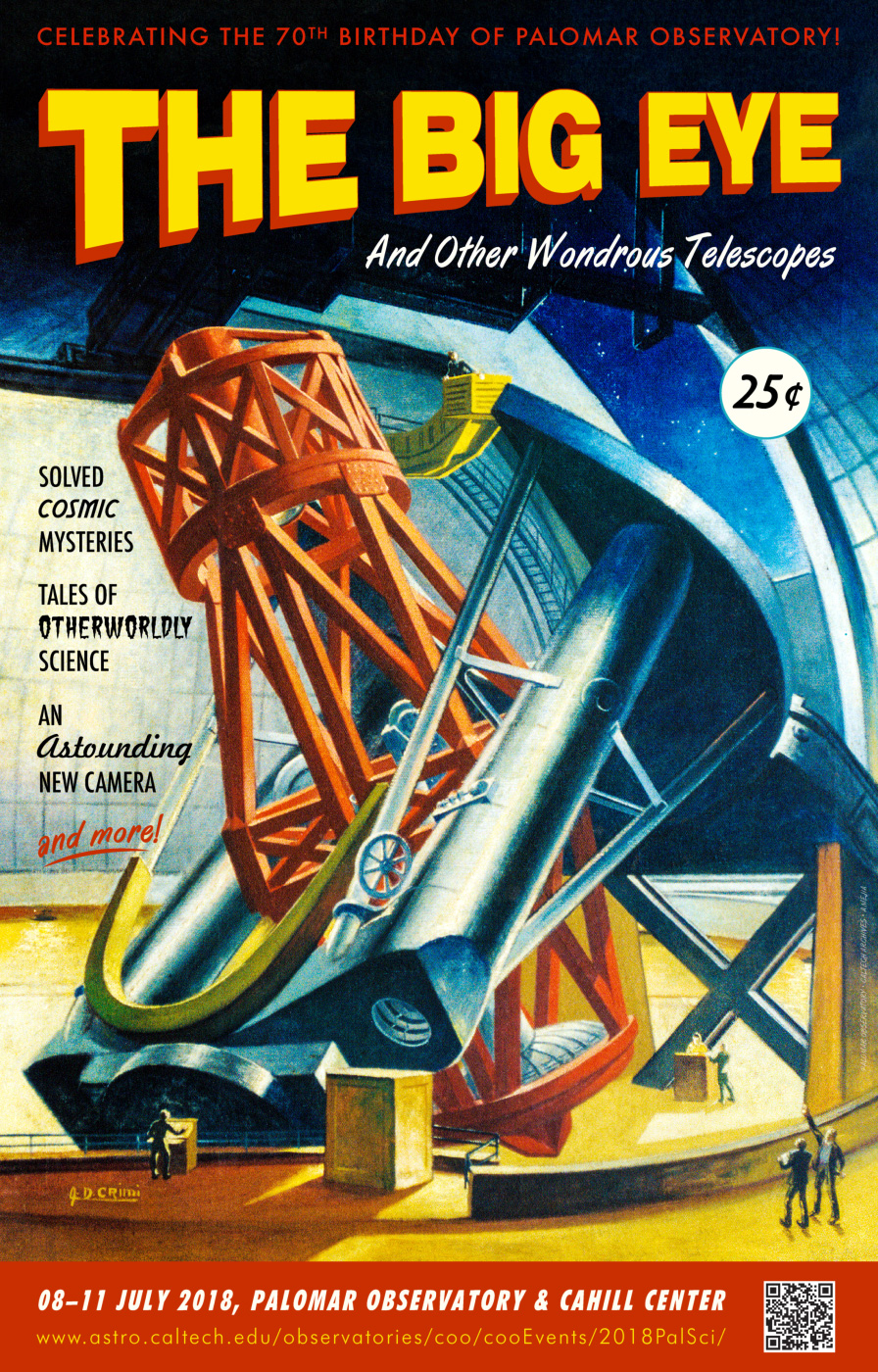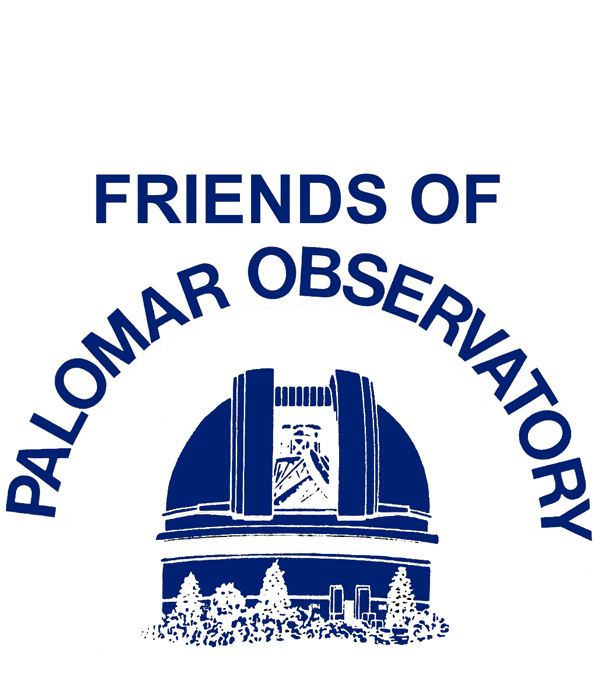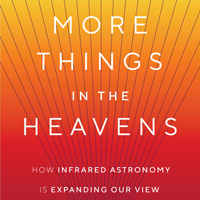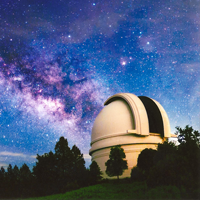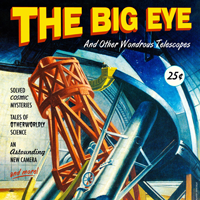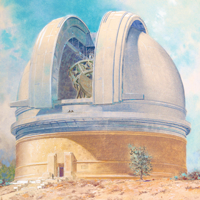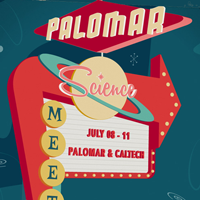Friends of Palomar Observatory Website
Upcoming Events

The Newsletter of the Friends of Palomar Observatory, Vol. 13 No. 1 – April 2018
Palomar 70th Anniversary:
Celebrating the Legacy and Anticipating the Future
By Andy Boden
In June 1948 the Palomar 200-inch telescope was dedicated as the Hale Telescope to posthumously recognize the extraordinary career of George Ellery Hale. Over a forty-year period Hale was the driving force in revolutionizing observational astronomy in the early 20th century, setting humankind firmly on a path to understanding its place in and connection to the universe. Hale’s crowning achievement, the 200-inch telescope and dome, stood as a monument both to his vision, and to the dedication and commitment of hundreds of engineers, scientists, and builders in their long effort to complete the project against the backdrop of the Great Depression and World War II. That June day at Palomar President Prof. Lee DuBridge spoke on behalf of the Caltech Trustees in dedicating Palomar Observatory as a whole, and its monumental centerpiece to Hale’s enduring legacy:
The Board of Trustees of the California Institute of Technology hereby resolve that the
200-inch telescope of the Palomar Mountain Observatory shall hereafter be known as THE HALE TELESCOPE
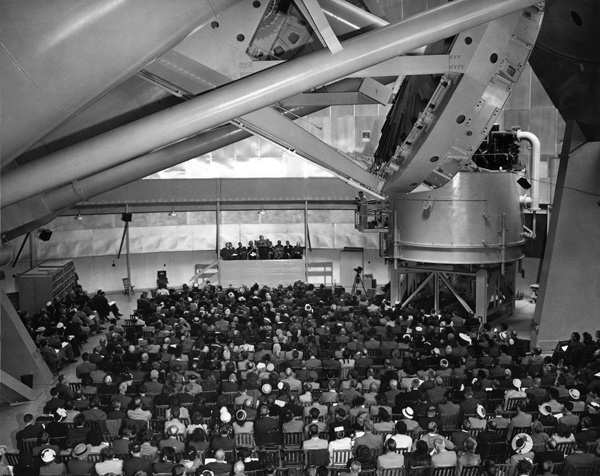
Caltech President Lee A. DuBridge formally dedicates Palomar Observatory and names the 200-inch the Hale Telescope on June 3, 1948. Nearly 1,000 invited guests attended the ceremony. (Palomar/Caltech)
In the 70 years since the Hale’s dedication, the telescope and its user communities have produced a record of seminal discoveries worthy of the namesake’s legacy. From establishing observational cosmology as a viable discipline, to framing our knowledge of stellar populations, galactic structure and elemental evolution, to studying the broad diversity and architecture of the Solar System, the Hale (together with its sister telescope the Samuel Oschin Telescope) dominated observational astronomy in the second half of the 20th century. Such observational work, and the subsequent theoretical insights it informed, frames human understanding of our place in universe. Moreover, Palomar’s iconic status and legacy have inspired generations of astronomers, science enthusiasts, engineers, artists, writers, and supporters worldwide. In this way Palomar’s echoes have touched a broad range of human endeavor, and enriched human culture in ways that are too numerous to count.
Today Palomar remains a relevant and prolific contributor to modern astronomical research, and a centerpiece in the Caltech research portfolio. Over the last decade the Observatory has led the way in the emerging field of transient astronomy (the study of sources that change brightness and/or position with time), and is the focus of a new national and international partnership with the Zwicky Transient Facility (ZTF). Innovative instrumentation on all the Palomar telescopes have extended their capabilities, efficiency, sensitivity, and resolution, with new initiatives to further extend the telescopes’ useful lives in development—and expected to see first light in the early 2020s. Modern data management and analysis methods facilitate new capabilities that early Palomar astronomers could only have dreamed of, and support from vital new partners such as UCSD/HPWREN make these data readily available to the greater Palomar community. More broadly, Palomar's scientific achievements are brought to the public through its outreach program: exhibits at the Greenway Visitor Center, guided tours, and online presence. Hale would surely be satisfied that even after 70 years of accomplishments Palomar remains an important contributor to humankind’s continuing search to comprehend its place in the cosmos, and the enduring impact his vision and leadership have had on astronomy.
To commemorate this Observatory milestone anniversary this year we are holding the 2018 edition of the Palomar Science Meeting 08 – 11 July at Palomar and the Caltech campus in Pasadena. More information in the article below.
Zwicky Transient Facility
By Steve Flanders
A theorist as well as an observational astronomer, Fritz Zwicky worked for most of his career at Caltech and during his tenure he made many contributions to our knowledge of the cosmos. A number of the hypotheses Zwicky raised in the 1930s now seem prescient and remarkably forward looking. During that decade, he proposed the concepts of dark matter and gravitational lensing, ideas that would become central to accepted cosmological theory only after many years had passed. In addition, while working with Walter Baade, Zwicky asserted that neutron stars were created in the core collapse and explosion of certain types of massive stars. He and Baade coined the term “supernova” to distinguish these events from less energetic and less luminous novae.

The Horsehead Nebula in Orion may be seen in this portion of the first-light image from ZTF taken November 1, 2017. Computers searching these images for transient events or variable sources are trained to recognize and ignore non-astronomical sources such as the vertical “blooming” lines seen here. (Caltech Optical Observatories)
Having personally discovered 120 supernovae and having seen them suddenly appear and then fade away, Zwicky understood that these transient events could reveal much about the dynamic universe and, for the skeptics, he asserted his belief that supernovae would, in his words, “eventually allow us to survey the universe to distances of billions of light years.”
A prescient idea! In this statement, Fritz Zwicky is telling his readers that, if they are concerned with the evolution of stars and galaxies, with the evolution of the universe itself, they must look at things that change. Years later, a number of science programs now are acting upon this idea and one of the most important of these saw first light on November 1, 2017 at Palomar Observatory under the auspices of Caltech and its partner organizations.
Successor to the Palomar Transient Factory (PTF) and the Intermediate Palomar Transient Factory (iPTF), the Zwicky Transient Facility (ZTF) is an automated survey designed to record anything that has erupted, varied in brightness, or changed position in the night sky. For this reason, the key function of the survey is to find and isolate objects that have changed, a task ZTF accomplishes in three ways:
First, the 576-megapixel ZTF camera is mounted in the 48-inch wide-field Samuel Oschin Telescope. With upgraded electronics, optics and telescope drive systems, the camera records objects to magnitude 20.5 in 30 seconds viewing on each exposure a section of sky large enough to encompass 247 full moons.
Second, the telescope moves so quickly and points so accurately that the camera is able to image the entire northern sky over three nights and the visible plane of the Milky Way twice each night. Four terabytes of data are generated on each observing night. The ZTF images are adjusted, cleaned and calibrated at Caltech's astronomy data center known as IPAC.
Third, each nightly dataset is added to an archive that will grow to more than 3 petabytes by the end of the three-year project. Having this sequential record and drawing upon machine-learning software, each newly acquired set of images is digitally compared to those taken previously. A subtraction technique then reveals the changes that have occurred in the sky while the software serves to identify objects that may be of scientific interest.
Zwicky Transient Facility Opens Its Eyes to the Volatile Cosmos. (Caltech Optical Observatories)
No doubt, all sorts of transients are of interest to the ZTF science community. ZTF will record transients that appear only for a short time as well as those that persist but vary in brightness from night to night. Astronomers are concerned, for example, with objects far from Earth that are the visible counterparts of events in the high-energy universe, in particular the afterglows of neutron star mergers, one source of gravitational waves. Supernova explosions are of continuing importance, especially in refining the cosmic distance scale.
In addition, ZTF is photographing each sky field 250 times a year and, by repeatedly reimaging each patch of sky, a continuous record of brightness changes is being created. On time scales of weeks and months, a distant quasar may vary in brightness in a manner that provides information regarding the accretion of material near its central black hole. In our galaxy, a star’s brightness may dim briefly but periodically suggesting the presence of a transiting exoplanet. The ZTF database is now capturing these light curves.
ZTF is a uniquely productive program of discovery. By scanning the sky faster than have previous surveys, astronomers are discovering a greater number of transients more quickly than has ever been possible. In fact, as Shrinivas Kulkarni, ZTF’s principal investigator and George Ellery Hale Professor of Astronomy at Caltech, has written, “Every second somewhere in the universe there’s a supernova that is exploding [and] with ZTF we will see tens of thousands of explosive transients every year.”
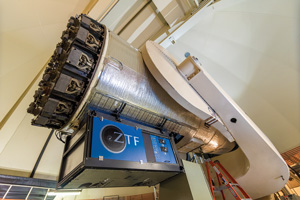
ZTF installed on the 1.2 meter Samuel Oschin Schmidt Telescope. The large format CCD camera at the heart of ZTF is located inside the telescope tube at the focus of the primary mirror. This telescope went into service at Palomar Observatory on September 24, 1948. (Caltech Optical Observatories)
But, this project has a broader dimension in which the Samuel Oschin Telescope serves as the first in a sequence of ever more powerful telescopes that are used to examine in detail the objects tagged by the learning software as being “interesting.”
The 48-inch telescope is the discovery instrument. Even so, to understand how stars are born, how galaxies are formed and how the universe has evolved, astronomers and astrophysicists need to know about the physical, chemical and dynamical properties of the objects the Schmidt has identified. Toward that end, two other telescopes at Palomar Observatory fulfill follow-up roles in ZTF.
The 60-inch telescope is used to quickly classify the interesting objects that have been found in the images made on the 48-inch telescope. Using a low-resolution integral field spectrograph and operating robotically, this instrument identifies the transients by category and makes the initial determinations that, among other things, segregate supernovae by type.
Finally, astronomers evaluate the data provided by the 60-inch telescope and select objects for detailed characterization using the spectrographs and related instruments on the Hale Telescope or on other premier telescopes around the world.
The Zwicky Transient Facility—a discovery telescope, a classification telescope, and a characterization telescope—these three working together produce data of the quality and quantity astronomers require to formulate and test their ideas and ultimately by many steps to advance our understanding of the universe.
Palomar Science Meeting 2018
This year’s Palomar Science Meeting (PSM2018) will be an inclusive opportunity for the Palomar community to gather in celebration of Observatory history, accomplishments, and bright future. Events at Palomar on 08 July will celebrate the history and legacy of the Hale and Samuel Oschin Telescopes, and provide an opportunity for participants to view these telescopes and recent renovations and enhancements at the Observatory. PSM2018 sessions 09 – 11 July 2018 at the Caltech campus in Pasadena will focus on recent Palomar science results, and center around a special public session Tuesday afternoon 10 July to dedicate the Zwicky Transient Facility. Further details on PSM2018 may be found at the meeting website.
As members of the Palomar community, Friends of Palomar Observatory are welcome to attend PSM2018. As attendance will be limited by venue capacity, individuals wishing to attend PSM2018 are strongly encouraged to register/RSVP for the meeting.
- Andy Boden
Questions? We've answered many common visiting, media, and academic questions in our public FAQ page.
Please share your feedback on this page at the
COO Feedback portal.
Big Eye 13-1
Last updated: 22 February 2021 ACM
